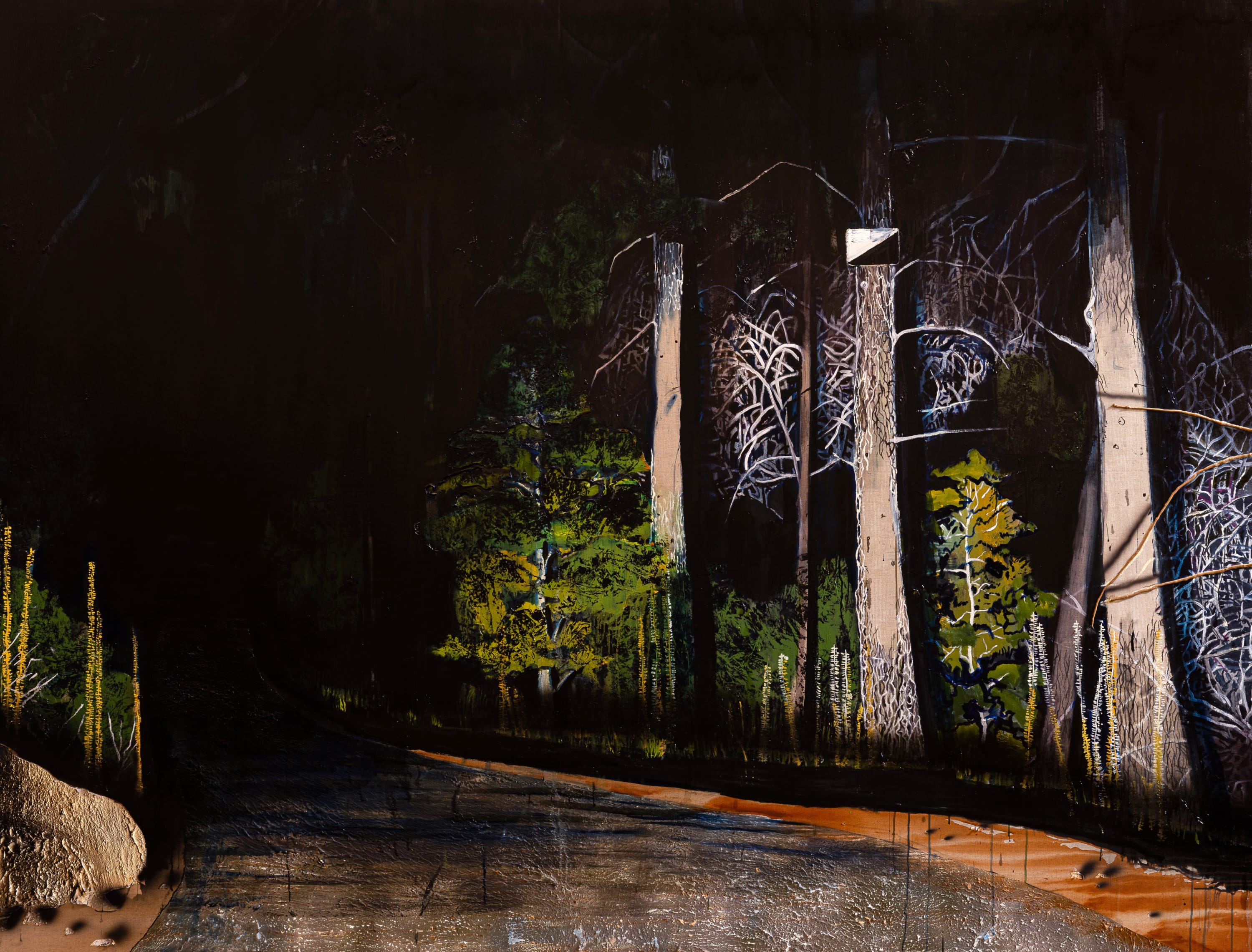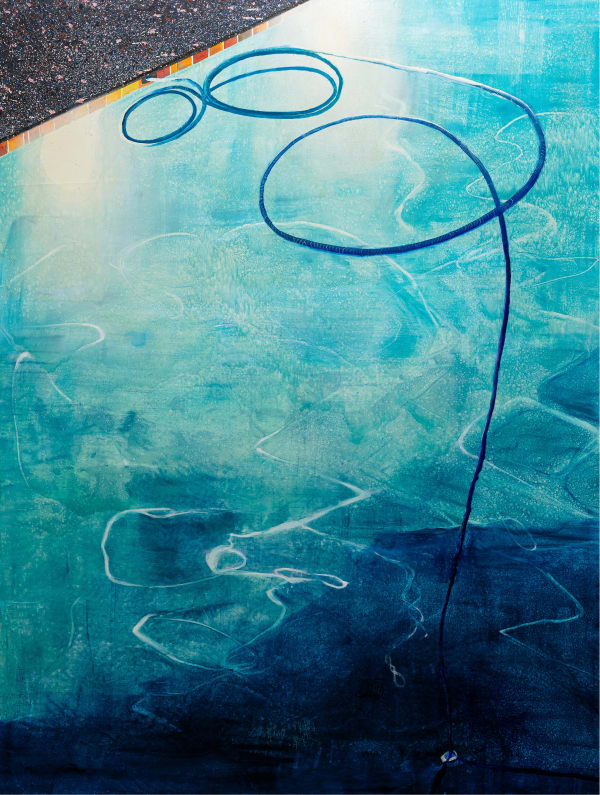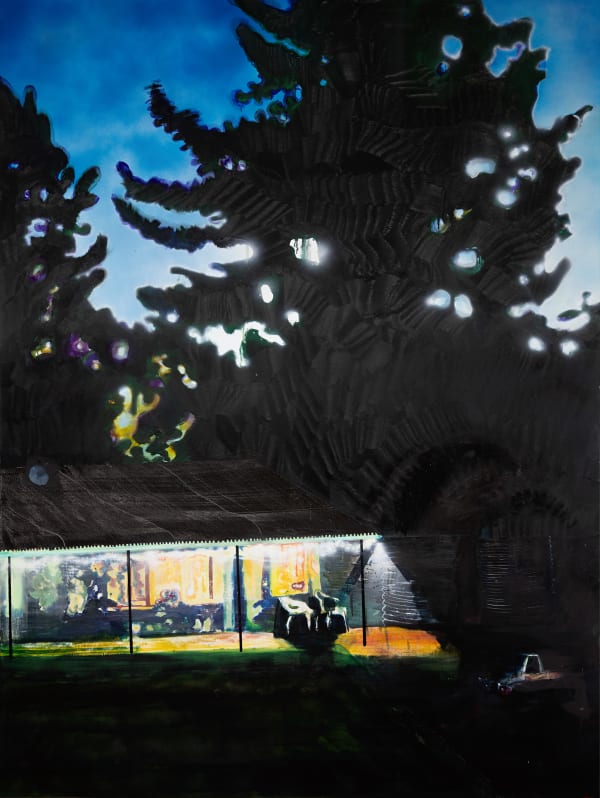WILLIAM MACKINNON: SNAKES AND LADDERS
-

-
Snakes and Ladders
William MackinnonLocation
Cuesta San Vicente 36
28008 Madrid Spain
Opening dates
April 22 - May 22, 2025
Opening hours
Tuesday - Friday: 11 am - 6 pm
Saturday: 11 am - 2 pm
Book your visit here
“Painting for me is a way of being in the world, a way of processing what it is to be human,” says William Mackinnon. His canvasses embrace life’s complexity by focussing on the everyday: open highways, country lanes and domestic spaces are transformed by the artist’s masterful use of light, offbeat perspectives and innovative approach to materials and technique. Each scene taps into the viewer’s lived experience, reworked into an emotional collage where reality teeters on the edge of magical.
A metaphor for lived experience
William Mackinnon: Snakes and Ladders borrows its title from the classic board game in which players roll dice to navigate from start to finish, helped by climbing ladders and hindered by sliding down snakes. Regarded as a metaphor for life itself, Snakes and Ladders plays on the same combination of excitement, trepidation and chance expressed in Mackinnon’s work.
Uncertain futures are referenced through the recurring motif of the road or partially lit path. Concepts of homecoming, departure and belonging are also significant to the artist, who currently resides in Ibiza and Melbourne, literally journeying through life to share time with family in both locations.
In The Silent Scream, a lone surfer traverses a beachscape, broken board in hand. An accident has occurred yet Mackinnon focusses on the protagonist’s hesitant steps into the future: “He goes on, over the rocks, through the seaweed. He’s not broken, but broken open. That’s why the show’s called Snakes and Ladders.”
Adventures in paint
Mackinnon views Snakes and Ladders as a metaphor for his creative process too. “Although I have a map, it’s about surprising myself,” explains the painter, who develops his works over various months and through myriad techniques. “When I get into trouble with a painting, it forces me into new territory. Without obstacles, surprising outcomes are unreachable.”
Daring and innovation characterise Mackinnon’s craft. He uses acrylics, oils, automotive paints and glitters, but also experiments with plasters and liquid nails adhesive, achieving an immense variety of textures and forms. Trees seem to grow on the canvas, turquoise waters sparkle freshness, black landscapes reveal layers of texture as the viewer’s eye adapts to the darkness.
“Each painting has its own momentum,” insists Mackinnon, whose approach combines playfulness and intense physicality. He sponges, drips and splatters his paint, flicks solvent onto the surface or sands it to generate new topographies. The result is a collection of paintings that are not so much viewed as felt, fragmented scenes in which the familiar and the bizarre mischievously coincide.
Magical mundanity
Mackinnon draws attention to the anti-heroic, encouraging viewers to observe their day-to-day. His paintings turn road signs, rubbish bins and pool hoses into protagonists, exploring the symbolism of everyday objects: “I’m interested in how we make meaning, using the things around us.” Road markings speak of trust, containers relate to family and “the speed bumps are about having children.”
Mackinnon’s subject matter makes his work immediately relatable, while his use of perspective often emphasises the viewer’s sense of inhabiting the scene. His skilful use of materials, textures and colour, meanwhile, lends his paintings a glitchy quality which elevates mundanity to magical. An emotional response, as the artist explains, is the only objective: “If I can be true to my experience of the world, then people get it. It’s not that I want someone else to feel my emotion; I just want them to feel something.”
Biography
Born in Melbourne, William Mackinnon now works between Ibiza, London and Melbourne. He studied at Melbourne University and was assistant to Kim Westcott and Tim Maguire before completing post-graduate training in London and Melbourne. He has held over 20 solo exhibitions, received numerous awards and featured in group shows at NGV Melbourne, the Art Gallery of South Australia and The Royal College, London. His work is held by collections and institutions including NGV Melbourne, Parliament House Art Collection (Canberra), Artbank Sydney and Colección SOLO.







